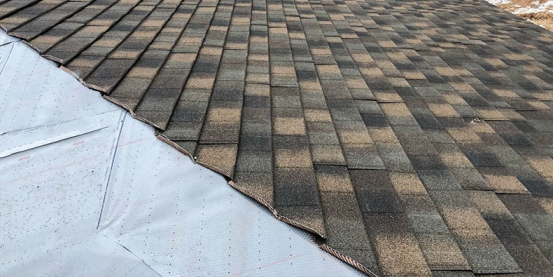THE LATEST IN ROOFING

Underlayment is a water-resistant material installed beneath the top roofing layer. As a critical part of the roof system, underlayment protects the structure during and after the installation process by:
· Preventing trapped moisture and repelling water.
· Providing an extra layer of protection against the elements.
· Enhancing the roof’s ability to withstand rain, wind, snow, ice and fire.
· Protecting the roof deck during installation.
Having the right underlayment in place will help prevent moisture from infiltrating and condensation from collecting inside your attic space.
There are three main types of underlayment for metal roofs, each with its own set of pros and cons. These include:
· Felt paper underlayment.
· Synthetic underlayment.
· Peel-and-stick (rubberized asphalt) underlayment.
Also known as tar paper, asphalt-saturated felt or asphalt-soaked felt.
Felt paper underlayment is typically made from a base of natural fibers or cellulose and then treated with a waterproofing agent such as asphalt.
Felt paper was once the most common underlayment, mainly due to the fact that it’s the cheapest. However, roofing professionals have increasingly shifted to the use of synthetic underlayment for metal roofing because it lasts longer and is more durable against the elements.
The short lifespan of felt paper creates a challenge when paired with a metal roof. Metal roofs can easily last for decades–or longer–so it’s important to consider the longevity of an underlayment product to ensure that it lasts as long as the roof.
Pros of Felt Paper:
· Least expensive underlayment.
· Easy to install with common tools.
· Readily available and easy to find.
Cons of Felt Paper:
· Short life span and will likely need to be replaced before a metal roof does.
· Breaks down when exposed to direct sun and high temperatures.
· Bubbles, buckles and wrinkles with just 24 hours of UV exposure.
· Asphalt is made from petroleum, which is a highly flammable material.
Synthetic underlayments are relatively new and have taken substantial market share from felt paper as they last longer and perform better in high temperatures, winds and exposure to the elements.
Synthetic underlayments are made of woven polyethylene or polypropylene fibers that are then treated with a resilient polymer to form a protective barrier between the roofing material and the underlying deck. Most synthetic underlayments are mechanically attached with roofing caps and staples.
In addition to their superior longevity and durability, synthetic underlayment can substantially increase the energy efficiency of a metal roof.
As a stand-alone product, metal roofs are one of the most energy-efficient roofing materials on the market, but when paired with advanced synthetic underlayments, the energy efficiency of metal roofing is amplified 4x. For example, a DECRA metal roof installed over felt paper improves thermal performance by 48%. When that same DECRA roof is installed over an advanced synthetic underlayment, thermal performance soars to 218%.
Pros of Synthetic Underlayment:
· Longest lasting type of underlayment and far more durable than felt.
· Tough thermoplastic polymers that are more resistant to tearing, movement and impact damage.
· Easy and fast to install.
· Can withstand up to a year of direct exposure to UV without drying out.
Cons of Synthetic Underlayment:
· The need for cap fastening also means a standard hammer-stapler is not an option.
· More expensive than felt.
Also known as ice and water shield, self-adhering membrane or rubberized asphalt.
Applied directly to the deck, “peel-and-stick” self-adhering synthetic underlayment products typically have a rubberized asphalt adhesive on one side that is protected by a peel-off membrane.
The rubber-like qualities of self-adhering synthetic underlayment make them self-healing, meaning that they seal extremely well around fasteners and penetrations. In fact, peel-and-stick synthetic underlayment is also referred to as an ice and water shield because it’s so effective at reducing the risk of water penetration. In regions prone to heavy rain and snow, building codes often require ice and water shield underlayment.
For example, when heat from the home rises to melt snow or ice on the roof, water can then seep into the roof’s nooks and crannies. A self-sealing peel-and-stick membrane can help seal around fastener shanks for a leak-resistant fit.
Valleys and other roof penetrations (such as skylights, plumbing vents and roof-to-wall intersections) can also benefit from peel-and-stick membrane underlayment installation.
Pros of Peel-and-Stick Underlayment
· Extremely effective for ice dam protection, especially in eaves, valleys and dormers.
· Ideal for a water-tight seal around penetrations.
· Lasts longer and performs better than felt.
· Contributes to a more resilient air barrier for better thermal performance.
Cons of Peel-and-Stick Underlayment
· Self-adhering underlayments must be properly installed. A careless installation can lead to the membrane peeling back over time, leaving the roof deck vulnerable to damage.
· More expensive than felt and synthetic.



REQUEST A QUOTE
Copyright © Hangzhou Singer Building Materials Co., Ltd. All Rights Reserved |
Sitemap
| Powered by 
SEOKeywords:Roof Tile ManufacturerRoof Shingle ManufacturerAsphalt Shingle SupplierRain Gutter CompanyShingle Roofing CompanyWaterproof Tape For RoofPressed Steel Roofing TilesRain Gutter SystemGray Asphalt ShingleStone Coated Metal Roofing Manufacturer